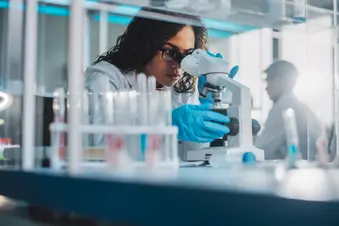
Chronic lymphocytic leukemia (CLL) starts in bone marrow, the soft inner part of your bones. There are some key differences that set CLL apart from other types of leukemia, such as ALL (acute lymphocytic leukemia), AML (acute myeloid leukemia), and CML (chronic myeloid leukemia).
Who Gets It
CLL is the most common leukemia in adults. Most people get diagnosed in their 60s and 70s. As you age, your risk increases. Other types, such ALL and AML, mainly happen in childhood. Kids usually don’t get slow-growing forms of leukemia.
Most people live with CLL much longer than with other cancers or other types of leukemia.
Where It Starts
CLL and ALL begin in the bone marrow, where blood cells are usually made. Specifically, it starts in a type of bone marrow cell called lymphocytes. (That’s what the first “L” in CLL and ALL refers to.)
Lymphocytes become a type of white blood cell, which helps your body fight off infections. But with CLL, the lymphocytes grow out of control. Blood tests often show a high white blood cell or lymphocyte level. You’d get more tests to find out if this is leukemia.
Two other types of leukemia -- acute myeloid leukemia (AML) and chronic myeloid leukemia (CML) -- start in myeloid cells in your bone marrow. Myeloid cells develop into white blood cells other than lymphocytes, red blood cells (which carry oxygen), and platelets (which form clots to help stop bleeding).
How Fast Cancer Cells Grow
The “C” in CLL stands for chronic. This means the cancer usually grows and spreads slowly, although CLL can also grow more quickly.
In contrast, types of leukemia that have “acute” in their name (acute lymphocytic leukemia and acute myeloid leukemia) grow much faster than most chronic leukemia. People with these types are usually very sick and need treatment right away.
If, like most people with CLL, you have the slow-growing kind, you might not notice any symptoms for years. A routine blood test might be the first clue that something’s wrong. You may not need treatment right away. (Your doctor will closely follow your health, of course.) Whether you need to start treatment depends on your symptoms, test results, and the stage (0 through IV) of your disease.
Doctors can test for common and uncommon proteins on the surface of CLL cells. The results help diagnose and treat it, as well as check on the prognosis (how the condition may affect you).
Show Sources
Photo Credit: iStock/Getty Images
SOURCES:
American Cancer Society: “Leukemia,” “If You Have Chronic Lymphocytic Leukemia (CLL),” “What Is Chronic Lymphocytic Leukemia?”
National Cancer Institute: “Chronic Lymphocytic Leukemia Treatment (PDQ) -- Health Professional Version,” “Adult Acute Myeloid Leukemia Treatment (PDQ) -- Patient Version.”
MD Anderson Cancer Center: “Childhood Leukemia.”
Nicole Lamanna, MD, associate professor of clinical medicine, Columbia University College of Physicians and Surgeons.
Cancer: “Adult leukemia survival trends in the United States by subtype: A population-based registry study of 370,994 patients diagnosed during 1995-2009.”